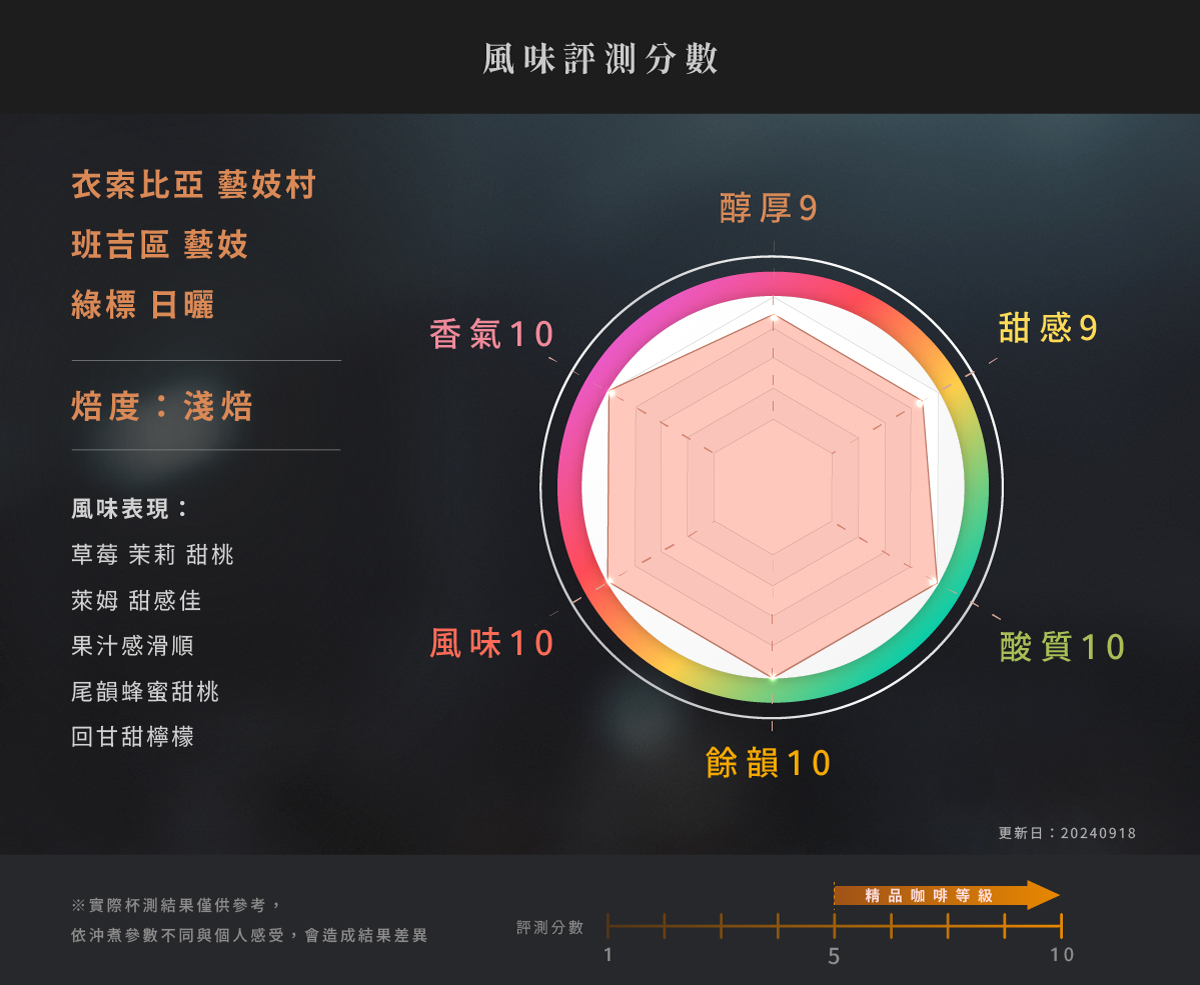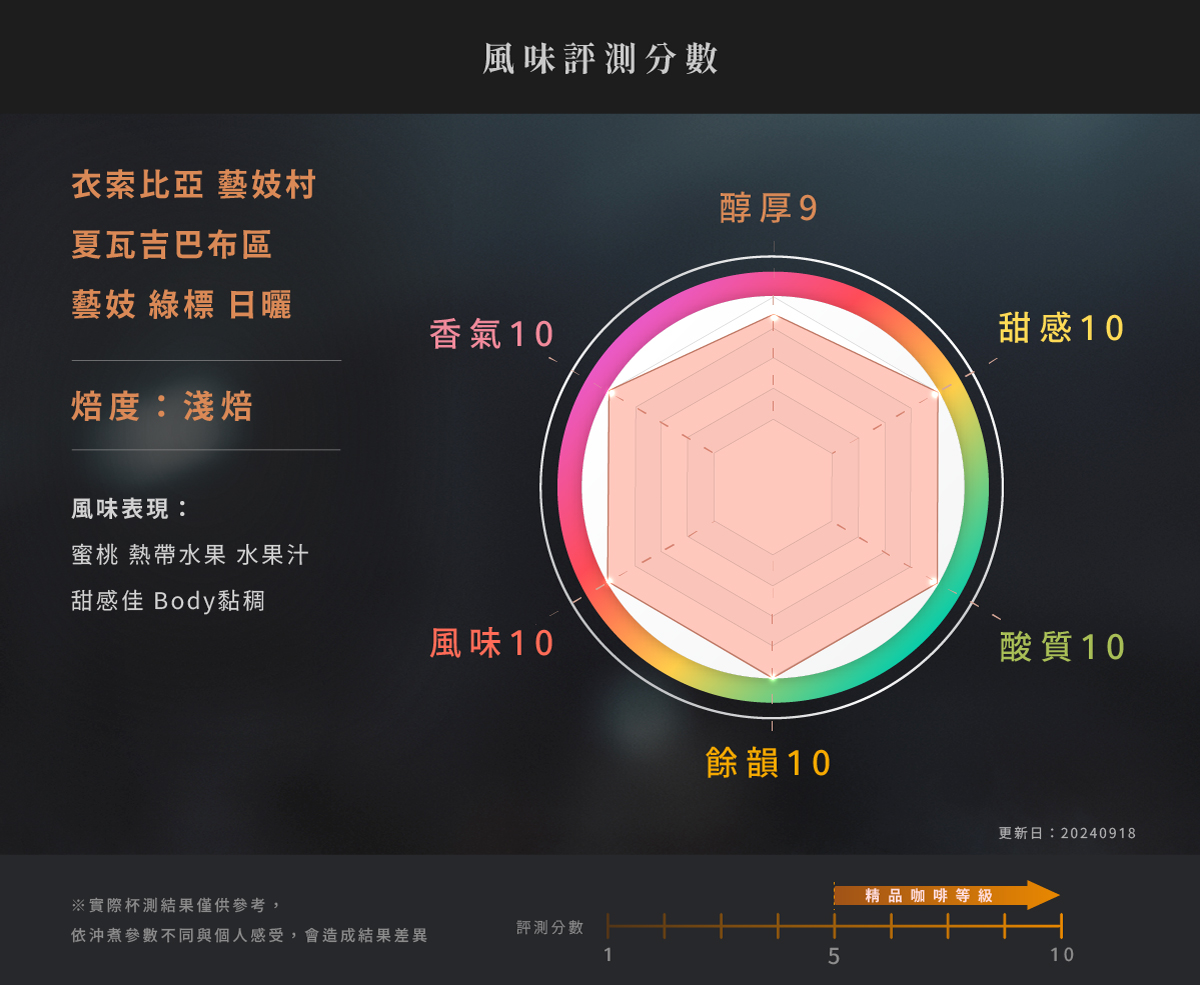

【Coffee tasting set】6 Gesha Village Green Label Coffee Experience Set
Detailed information about the coffee beans is as follows:
1) Ethiopia Ethiopia Gesha Village Bangi Gori Gesha Green Label Washed
2) Ethiopia Gesha Village Bangi Gori Gesha Green Label Natural

3) Ethiopia Gesha Village Shaya Gori Gesha Green Label Washed
4) Ethiopia Gesha Village Shaya Gori Gesha Green Label Natural
5) Ethiopia Village Shewa-Jibabu Gori Gesha Green Label Washed
6) Ethiopia Village Shewa-Jibabu Gori Gesha Green Label Natural






Coffee Flavor
The flavors of coffee are derived from the breakdown of various nutrients in the green coffee beans during roasting. Heat causes these compounds to degrade into a variety of aromatic molecular structures, resulting in a wide spectrum of flavors. High-quality coffee beans naturally possess a rich aroma that evolves at different temperatures—high, medium, and low—offering a delightful and nuanced experience worth savoring.

Ethiopia Gesha Village
At Gesha Village, every step of cultivation and processing is dedicated to uncompromising quality. Each batch is marked by rich floral and fruity aromas, characteristic coffee flavor elements, and is carefully graded. Through a rigorous cupping process, each batch is meticulously selected, evaluated using the Specialty Coffee Association (SCA) protocols, and classified according to Gesha Village’s grading system. These batches are then offered to global buyers, ranging from extremely rare treasures to fully traceable single origins. The grading system is as follows:
Gold Label: Rarities
The Gold Label represents rare treasures, making up only 10% of Gesha Village's total estate production. Extremely scarce, these coffees feature top-tier flavor characteristics, pronounced and lasting aromas, and a refined texture. This grade is where auction lots are selected and is often the first choice of international baristas for competitions.
Red Label: GROWERS RESERVE
The Red Label batch accounts for only 15% of the estate's production. It showcases exceptional flavor and quality, consistently scoring above 88 points on the SCA cupping scale.
Green Label: SINGLE TERROIR
The Green Label batches originate from a single region within the Gori Geisha Village. Each batch has complete traceability, including details such as the farm block name, coffee variety, and processing date.
Gori Geisha Village Overview
Gori Geisha Village is located in the Bench-Maji zone of Ethiopia, covering a total area of 471 hectares, with 320 hectares dedicated to coffee cultivation. The village sits at an elevation ranging from 1909 meters to 2069 meters above sea level. Conservation areas make up 27% of the total land. Based on climate and variety, the farm is divided into eight plots: Bangi, Shaya, Oma, Shewa-Jibabu, Dimma, Gaylee, Narsha, and Surma. The Bench-Maji zone, situated in southwestern Ethiopia, is home to one of Ethiopia's two major primary forest coffee regions. Coffee trees grow under the natural shade of the forest, utilizing sustainable practices such as intercropping and shade-grown methods to promote environmental stewardship.
The goal of Gori Geisha Village is to become Ethiopia's finest and most environmentally conscious coffee farm. They are committed to uncompromising quality in every step of cultivation and processing while fostering dedication to both their employees and customers. The farm aspires to connect the world to Ethiopia and showcase its beauty through a perfect cup of coffee.

藝妓/瑰夏種Geisha/Gesha Variety
Geisha coffee, listed by Forbes as one of the "World's Top 10 Most Expensive Coffees," is a legendary name in the specialty coffee world. The Geisha variety is surrounded by significant confusion, as several genetically distinct plant types are referred to by this name. Many of these plants share similar geographical origins in Ethiopia. Recent genetic diversity analysis by the World Coffee Research Center confirms that the T2722 variety, cultivated in Panama, has a unique and consistent lineage. When properly managed in high-altitude regions, this variety is strongly correlated with exceptional cupping quality, celebrated for its refined floral, jasmine, and peach-like aroma.
The spelling of Geisha or Gesha is often used interchangeably, influenced by phonetic transliteration without a fixed standard for translating Ethiopian dialects into English. The coffee was initially recorded as "Geisha" in planting records, and for decades, researchers and planting databases adhered to this spelling, which was subsequently adopted and promoted in the coffee industry. This variety was originally collected from a mountain in Ethiopia, whose name is typically translated into English as either "Gesha" or "Geisha."
果利藝妓(Gori Gesha)
Named after the Gori Gesha Forest, the origin of Geisha coffee, this variety preserves the genetic diversity found in the forest. It is a rare privilege to experience the native Geisha variety, which, through meticulous care, scientific management, and strict quality control, represents the authentic taste of Ethiopian Geisha coffee.

(Coffee Processes)
The term "processing methods" refers to the process of transforming ripe red coffee cherries into dried green beans. Each method has its advantages and disadvantages, influenced by the natural environment and the specific needs of the coffee-producing region. As a result, different regions adopt the processing method most suited to their conditions. This batch uses the following natural and washed processing methods, described below:
【Natural / Sundried / Dry Processed】
Also known as the natural drying method or unwashed process, the natural process is one of the most traditional and widely used methods of coffee processing. This method does not involve the use of water. Originating in Ethiopia, coffee cherries are harvested and laid out to dry under the sun before being hulled. The seeds remain inside the fruit throughout the extended drying period, absorbing flavors from the skin, pulp, and mucilage. This process enhances the coffee's sweetness and body, often resulting in unique and distinctive aromas.
Producers spread the cherries on drying beds, which may consist of terraces or raised platforms. Over the course of 3 to 6 weeks, the cherries undergo fermentation. Producers turn the cherries regularly to ensure even drying and to prevent spoilage. During this time, the sugars in the fruit and the mucilage adhered to the seeds develop complex flavors, contributing to a sweeter profile.
Once dried, the fruit layers are mechanically removed from the seeds. Natural-processed coffee is often juicy and syrupy, with a rich flavor that makes the effort behind this method well worth it.
【Washed / Wet Processed】
Also known as the wet process, this method involves removing the skin and pulp of the coffee cherries before drying. The seeds are then fermented in water tanks to eliminate the remaining mucilage on their surface, followed by thorough washing and drying under sunlight or with mechanical dryers.
The washed process produces a cleaner and crisper flavor profile compared to the natural process. Coffees processed this way typically have lighter body, brighter acidity, and distinct fruit flavors. This method is often associated with specialty coffee due to its clarity and vibrant flavor expression.





JUSTIN INTERNATIONAL FOOD ENTERPRISE CO., LTD.
Tel: +886-3-358-6611
1st Floor, No. 30, Lane 120, Daxing Road, Taoyuan District, Taoyuan City
▶This product is covered by a NT$10 million product liability insurance.
▶Food Industry Registration Number: F-165601955-00000-0
▶ Our company’s cupper is certified as a CQI International Coffee Quality Appraiser.



Recommended Products


※ 詳細出貨及付款說明、發票、海外訂購須知...等,請 點擊進入